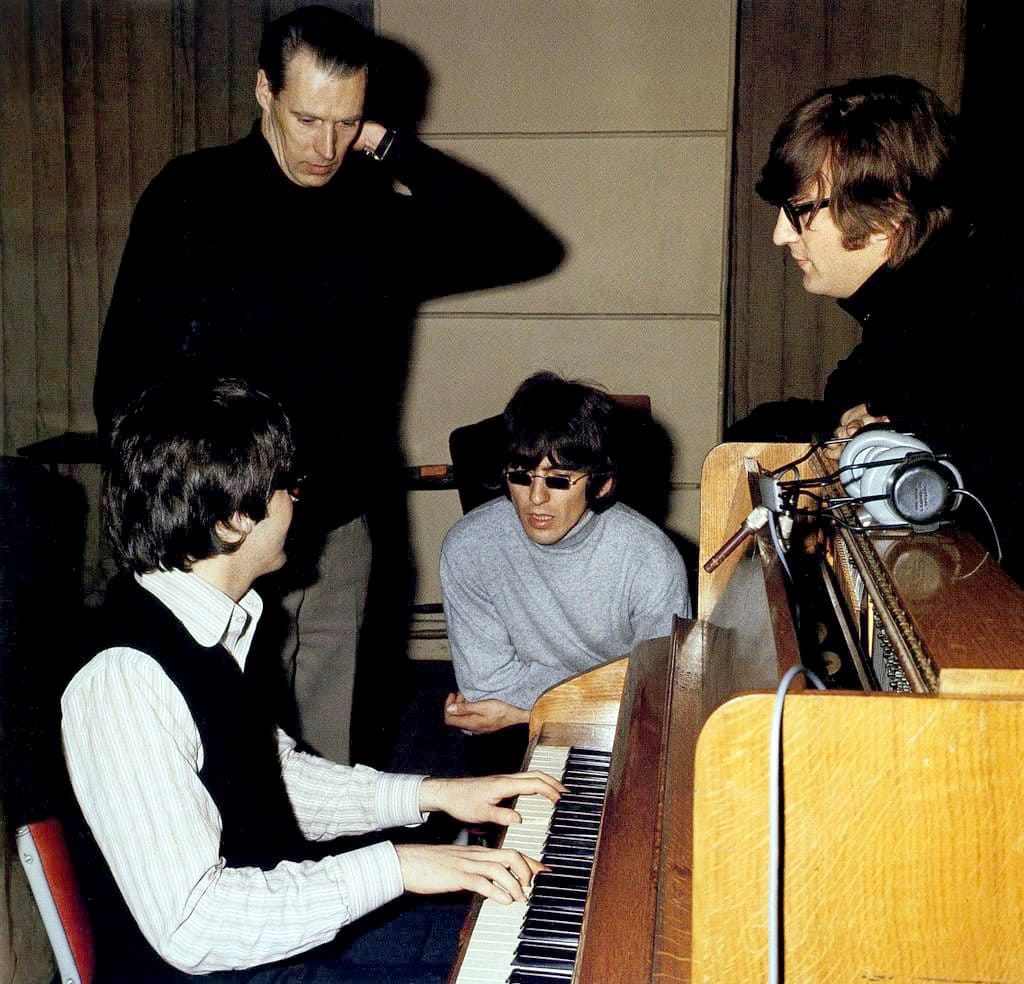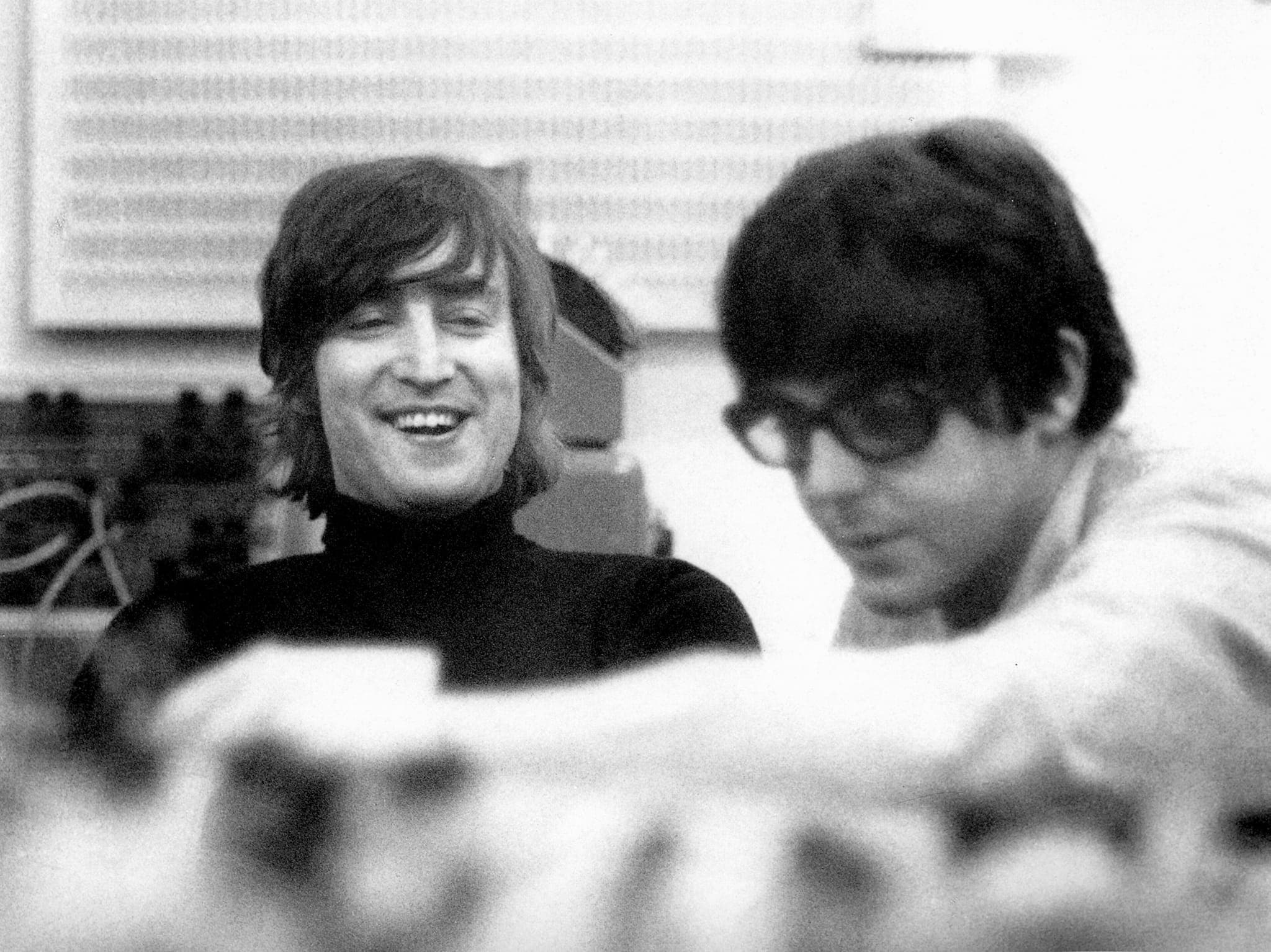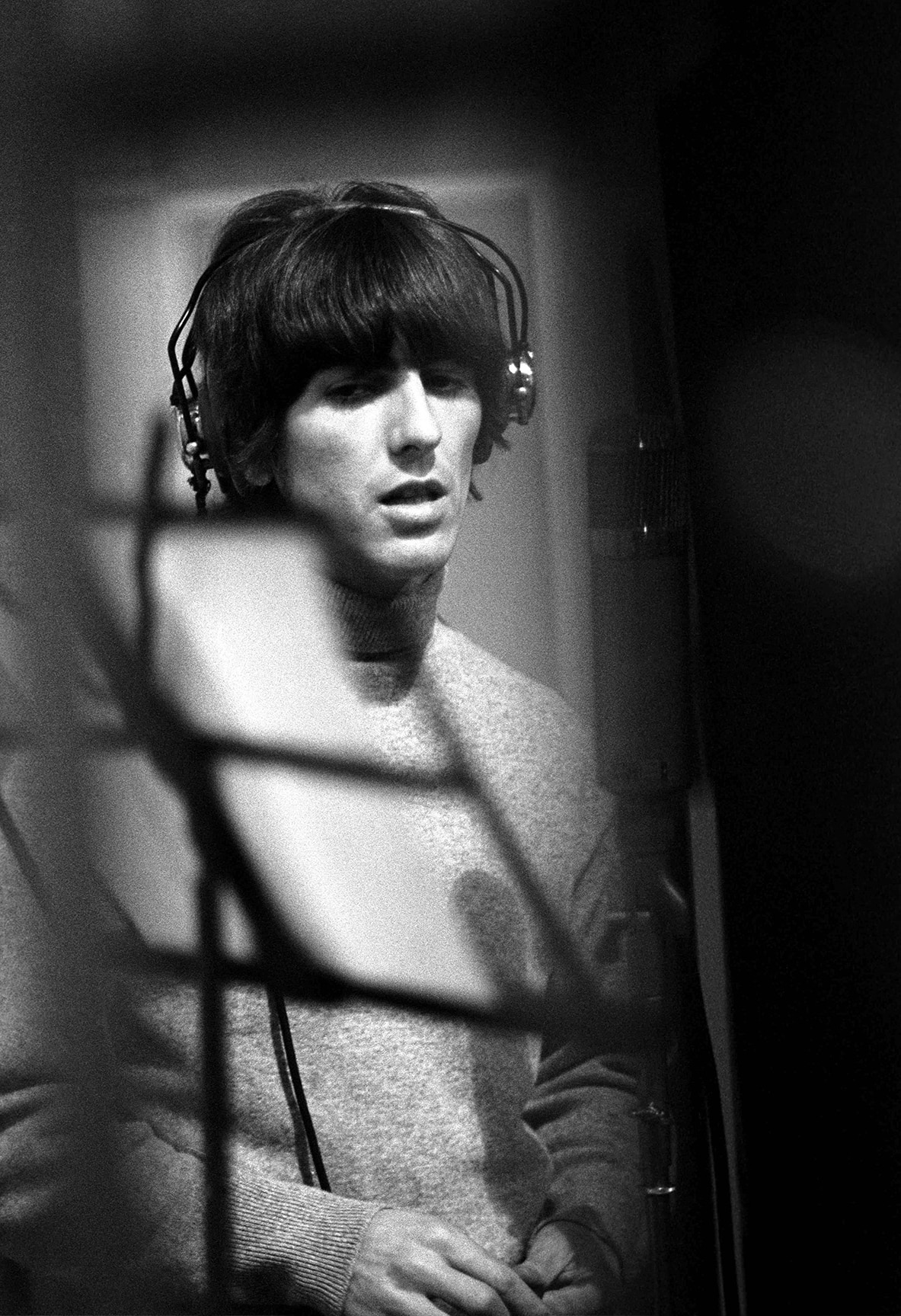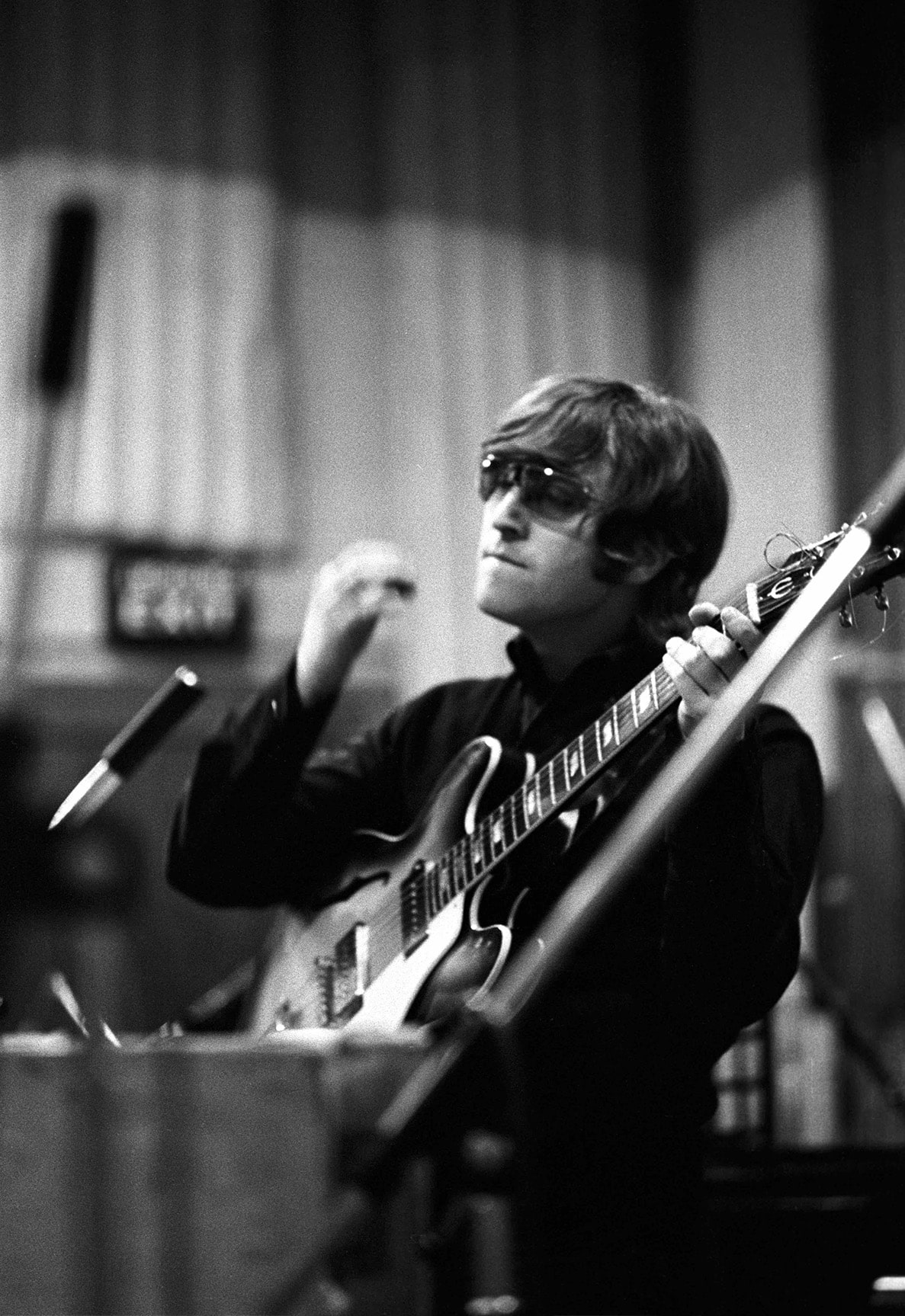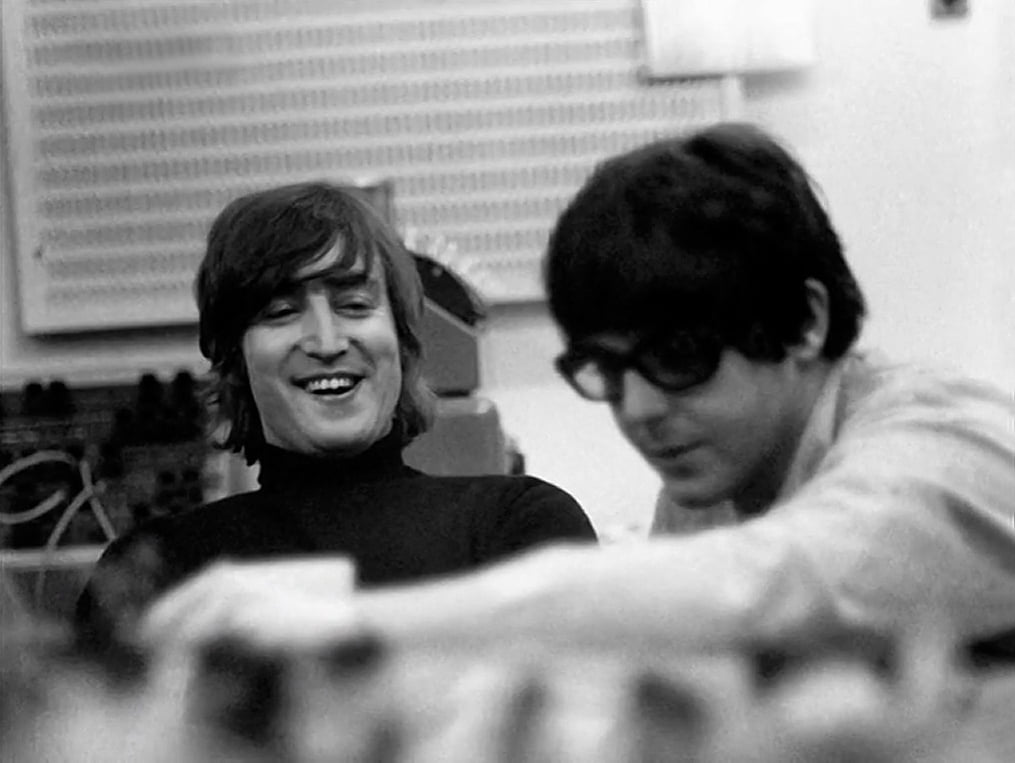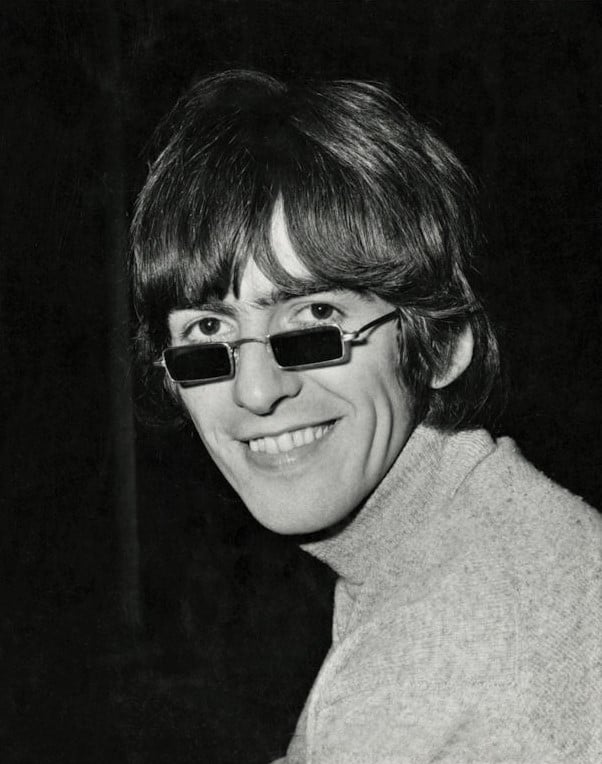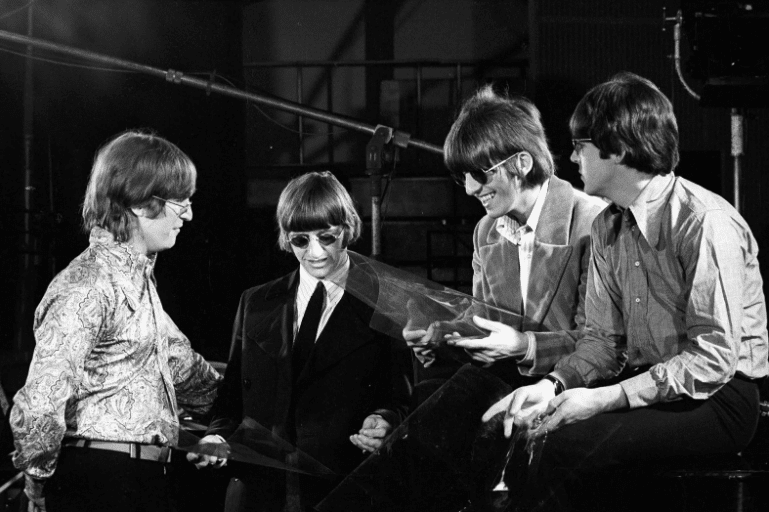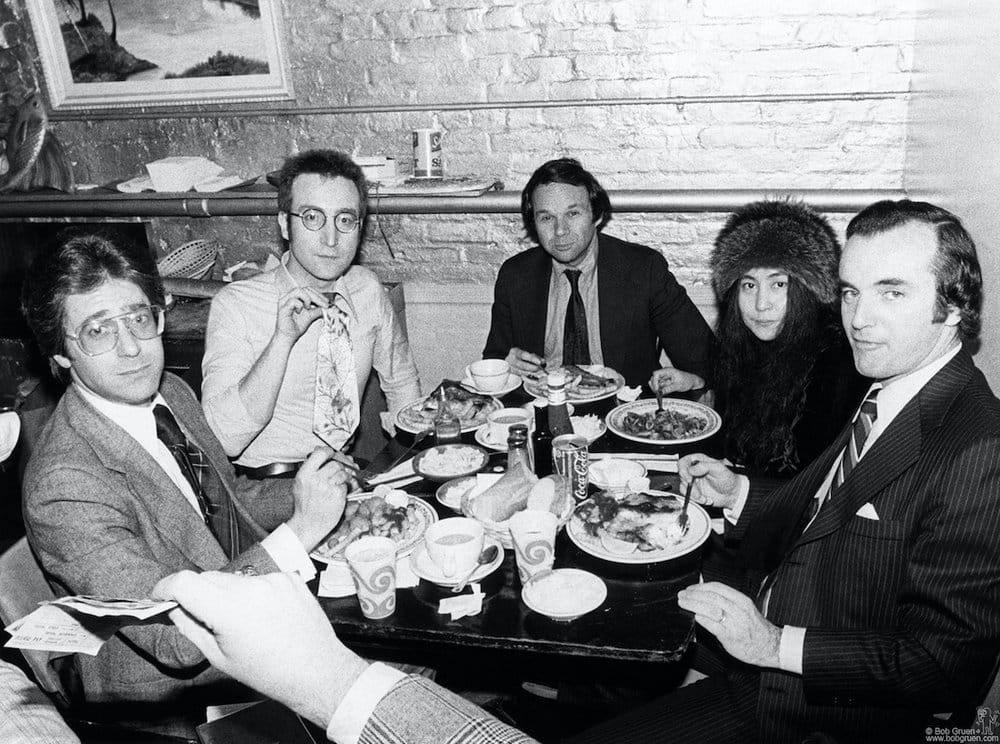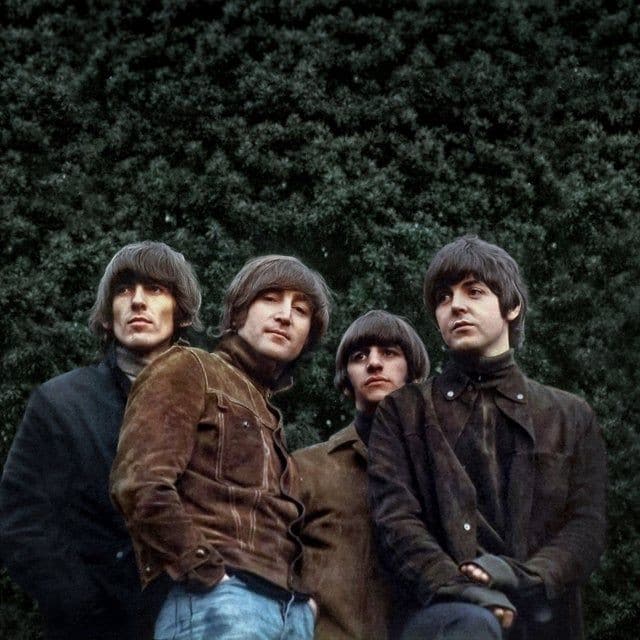Revolver
Side One, Track Six
We Dive Deep With A “Yellow Submarine”
by Jude Southerland Kessler, Laura Cortner, and Dr. Bob Hieronimus
Through 2023, the Fest for Beatles Fans blog has been enjoying some time well spent with the songs on The Beatles brilliant LP, Revolver. This month, Laura Cortner and Dr. Bob Hieronimus, authors of Inside The Yellow Submarine and It’s All in the Mind: Inside The Beatles’ Yellow Submarine, Vol. 2 join Jude Southerland Kessler, the author of The John Lennon Series, for a fresh, new look one of the most beloved Beatles tracks of all time. Laura and Bob have collaborated on several books that have been translated into multiple languages. In addition to their research into the Yellow Submarine, their titles include Founding Fathers, Secret Societies (2006), United Symbolism of America (2008) and Secret Life of Lady Liberty: Goddess in the New World (2016). As an artist and symbologist, Robert R. Hieronimus, Ph.D., has been on a mission since 1968 to discover the hidden reality behind The Beatles’ Yellow Submarine, and he has lectured on the subject around the world including at Abbey Road Studios in London. His doctoral research on the symbolism of the Reverse of the Great Seal of the United States has been used by the White House, State Department, Department of the Interior, and published in the Congressional Record, and his radio interview program, 21st Century Radio®, exploring consciousness and alternate realities, has been on the air since 1988.
What’s Standard:
Dates Recorded: 26 May 1966
Time Recorded: 7.00 p.m. – 1.00 a.m.
Studio: EMI Studios, Studio 3
In 4 takes, a basic rhythm track was recorded featuring Ringo on drums, John on the Gibson Jumbo, Paul on bass and George on tambourine. Ringo’s lead vocal and the backing vocals provided by his mates were overdubbed onto this fourth “best” take.
Tech Team
Note: On this night, George Martin was absent due to food poisoning. However, he sent his soon-to-be wife Judy Lockhart-Smith to make sure The Beatles had all they required.
Producer: Geoff Emerick
Engineer: Geoff Emerick
Second Engineer: Phil McDonald
Date Recorded: 1 June 1966
Time Recorded: 2.30 p.m. – 2.30 a.m.
Studio: In Studio 2, The Beatles were joined by Brian Jones and Mick Jagger, Marianne Faithfull (Jagger’s girlfriend), Pattie Boyd Harrison, Beatles chauffeur Alf Bicknell, Mal Evans and Neil Aspinall, and of course, George Martin, Terry Condon, and John Skinner “mucking in and making all manner of noises” (as Mark Lewisohn phrased it in The Complete Beatles Chronicle, 223) to enhance the basic track with vocal embellishments. These included John’s superimposed “nautical” voices and a whole host of special trappings from the EMI sound effect boxes.
Tech Team
Producer: George Martin
Engineer: Geoff Emerick
Second Engineer: Phil McDonald
Instrumentation and Musicians:*
Paul McCartney, the composer, played bass on his 1964 Rickenbacker 4001S and sang backing vocals.
John Lennon, who also contributed to the song’s creation, as you will see in the “Fresh, New Look segment,” played rhythm guitar on his 1964 Gibson J-160-E acoustic and sang backing vocals. He supplied spoken vocal superimpositions on 1 June.
George Harrison sang backing vocals and played tambourine.
Ringo Starr wrote “about 5 words” of the song, sang lead vocal and played his 1964 Ludwig Oyster Black Pearl “Super Classic” drum set.
*This information (with the exception of the information about Lennon’s lyrics) is from Hammack’s The Beatles Recording Reference Manual, Vol. 2, 141.
Sources: Lewisohn, The Complete Beatles Chronicle, 223-224, Lewisohn, The Recording Sessions, 80-81, Margotin and Guesdon, All the Songs, 334-335, Winn, That Magic Feeling, 22-23, Womack, Long and Winding Roads, 140-141, Hammack, The Beatles Recording Reference Manual, Vol. 2, 141-143, Turner, A Hard Day’s Write, 108-109, Davies, The Beatles Lyrics, 162-163, Spizer, The Beatles for Sale on Parlophone Records, 214, Spizer, The Beatles Rubber Soul to Revolver, 217, MacDonald, Revolution in the Head, 165, Mellers, Twilight of the Gods, 75, Kruth, This Bird Has Flown, 154, Riley, Tell Me Why, 187-188, and https://en.wikipedia.org/wiki/Barbara_Moore_(vegetarian_activist)
What’s Changed:
- A True Group Effort – Another genius of the 1960s, Ray Kroc (the founder of McDonald’s) once said, “None of us is as good as all of us.” And that adage is proven by the creative dibs and dabs contributed by The Beatles (and friends) to complete “Yellow Submarine.” The song has always been attributed primarily to Paul – coming to him in a dream (as did his “Yesterday”). But in our “Fresh, New Look Segment,” Laura Cortner and Dr. Bob Hieronimus add to our knowledge of this subject.
Furthermore, a plethora of musicians and friends added special flourishes to the song. Ringo gifted Paul the line “Every one of us has all we need.” John suggested repeating the lyrics, in Goon fashion, of the third couplet; he also wrote the introductory poem (later discarded). Donovan says that one evening Paul stopped by his house, asking for a couple of suggestions for the closing lines of the song, and Donovan accommodated with: “Sky of blue, sea of green.” Then, as Laura and Dr. Bob will tell us in more detail, The Beatles threw a fête in studio to happily trim the song in a bevy of uncommon sound effects. Truly, this song came to life “with a little help” from Paul’s friends.
- A Recurring Sense of Nostalgia – 1965 and 1966 were successful, hectic, creative, and remarkable years for John, Paul, George, and Ringo. But those days were also harried, unrelenting, and beleaguered. And as the four young men persevered, they began to reflect on their past and write about the “good ole days” – the simpler times. “When I was younger, so much younger than today/I never needed anybody’s help in any way,” John reflected in “Help!” Just a few months later, on the Rubber Soul LP, he reminisced: “There are places I remember/All my life, though some have changed.” And here, in “Yellow Submarine,” Paul looks back to the unpretentious joys of “little girl and boy land,” recalling his childhood in the seaport of Liverpool. “Yellow Submarine” is loaded with colorful images of imagination, play, and innocent joy.
In Twilight of the Gods, Mellers comments that “the music [of ‘Yellow Submarine’] has a talismantic function, recalling a Liverpool childhood” that all four boys shared. He reminds us that in the song, “The departure for the Sea of Dreams is from Liverpool Pier Head.” (p. 75) Increasingly in 1966, The Beatles longed for the lost magic of childhood: the thickly limbed trees of Strawberry Field, the busy hum of the Penny Lane roundabout, the Docker’s Umbrella (the overhead railway under which workers used to gather during the rain), and the choppy, green Mersey giving way to the Irish Sea. As the pressures of Beatlemania and the music industry bore down upon the lads, those halcyon days of “yesterday” when all their problems “seemed so far away” increasingly became a safe haven.
- A Discarded Introductory “Verse Melody” – So much is unique in “Yellow Submarine” that we’re not at all surprised to discover that the original version of this song began with a poem or a “verse melody” as John C. Winn calls it in That Magic Feeling, 22. This unusual intro was written by John in the style of In His Own Write or A Spaniard in the Works and then read on the recording by Ringo. The ditty was a tribute to Dr. Barbara Moore, who in 1960 completed a rather remarkable walk for charity from John O’Groats to Land’s End in 23 days. (MacDonald, 165) Originally, the song began with Ringo reading: “Yellow Submarine. And we will march till three the day to see them gathered there. From Land O’Groats to John O’ Green, with Stepney do we tread. To see a yellow submarine. We love it.” (In The Beatles Rubber Soul to Revolver, p. 217, Spizer notes that the next to last line of lyrics are: “to see his yellow submarine.”) You can hear this discarded introduction on the “Real Love” Maxi CD single.
- Song Released Simultaneously as a Single and as a Track on a Beatles LP – “Yellow Submarine” was released as a double-sided A-track single with “Eleanor Rigby” whilst also filling the fourth track slot on Side One of Revolver. This practice was very rare; however, it wasn’t the first time that The Beatles had placed a single on an LP.
In The Beatles Rubber Soul to Revolver Bruce Spizer points out that the boys had released “A Hard Day’s Night” on a single as well an including it in the LP by that name. But he goes on to say, “What made the ‘Yellow Submarine’ c/w ‘Eleanor Rigby’ single so different was it was not plugging a film. In addition, the decision by EMI to release the ‘Yellow Submarine’ single was made after Capitol Records had already decided to release the songs as a single. The Beatles did not object because by that time they were tired of other artists scoring hits from their album tracks. After all, ‘Michelle’ by the Overlanders went to Number One in the U.K. As George Harrison put it: ‘We just thought we may as well put it out instead of sitting back and seeing dozens of cover versions all getting hits. Well, we might as well cop the hit as well as anybody else.’”
- A Children’s Song For Us All – Although the appeal of “Yellow Submarine” is ageless and universal, Paul’s original intent was to write a children’s song. Hunter Davies points out that Paul intentionally employed “short words and short sentences, so that children would easily be able to learn it.” (Beatles Lyrics, 163) For me, Paul’s success in doing precisely that was, “measured out in years” a little over three decades later. In September of 2001, I lived in Morrisville, PA, located about 40 miles from Ground Zero, New York City. The pilot of the second plane that hit the Twin Towers resided one street over from my house, and our town (like every town in America) was completely devastated. Silent. In mourning.
In the stillness that covered everything – especially without the accustomed sound of planes winging overhead – I set out to paint my deck. It was work I would have ordinarily enjoyed with music booming in the background. But in those days, everything was eerily quiet.
And then I heard it…from two doors down…the sound of children playing in an autumn backyard. Children “ringing around the rosie” or skipping rope or engaging in some other fond, old ritual that required a happily-metered backdrop. At first, their song was hushed, but as they sang, the sound swelled and danced and found its way to me.
Tears filling my eyes, I stopped painting, paused, and listened:
“We all live in a yellow submarine,
Yellow submarine, yellow submarine…”
And there it was: the sound of hope. The sound of the world rallying. The sound of The Beatles reminding us all that over loss and fear and tragedy and even grief, peace prevails.
I realize that through the years The Beatles must have heard his song covered by the best of the best. But I would have given anything for them to be there on that emotion-filled afternoon…to hear those children in joyful chorus. Still today, when someone mentions 9/11, I flash back to that backyard moment when the aching sadness of those lonely weeks was lifted and once again, I began to believe in a world “where everyone of us has all we need.” The Beatles had created a “children’s song” for the child in all of us.
A Fresh New Look:
Recently, we sat down with Fest friends and noted authors Dr. Bob Hieronimus and Laura Cortner to discover what is going on behind the scenes in “Yellow Submarine.”
Jude Southerland Kessler: Laura and Bob, to me this seems to be the third song in a trilogy of songs about Liverpool, the other two being “Strawberry Fields Forever” and “Penny Lane.” The latter songs are set in the suburbs of Woolton, where John and Paul grew up. (Paul was from Allerton, which is quite close by.) But “Yellow Submarine” is so attuned to Liverpool. Do you see that connection?
Laura Cortner and Dr. Bob Hieronimus: Yes! But your question is prescient because now we can see the connection even more clearly since the release of the box set of Revolver last year. One of the most talked about outtakes in the 50th anniversary of the Revolver album was the new version of the song “Yellow Submarine.” This work tape had never been heard before: it had never been bootlegged; it had not even been rumored about. What is astonishing is the revelation that “Yellow Submarine” is not entirely a Paul song as we have all believed up until now. I think even Paul and John remembered it wrong themselves. This song started as one of those amazing collaborations that the two of them did so well, combining one song fragment John was working on, together with another, seemingly unrelated song fragment that Paul was working on. Somehow, with that particular Beatles magic, the combination and the result is a much greater sum than the parts. John contributed the familiar melody we know from the beginning of “Yellow Submarine” and the first few words, but he was headed into a minor key with very personal lyrics:
“In the place
Where I was born
No one cared
No one cared
”In the town
Where I come from
No one cared
No one cared…”
Listening to these outtakes can change your feelings about this song “Yellow Submarine,” and as you say, you immediately hear it as a song about Liverpool. The fact that they joined this snippet to a child-like sea shanty that Paul was working on about a yellow submarine further compliments your theory. Ringo’s lead vocals with his strong accent creates an echo back to the folk songs the lads must have heard from the sailors on the docks surrounding their childhood homes.
Producer Giles Martin was as astounded as anyone to discover these new work tapes. He enjoyed mostly the sharing and collaboration dynamic, which he points out is even more prevalent “on the next album, Sgt. Pepper’s, where Paul has this endless enthusiasm of singing, ‘It’s getting better all the time’ and John sings, ‘It can’t get much worse’ back. [laughs] That’s the way they were. And I think that this whole [Revolver] album is them being individuals, but they have complete empathy for each other’s talents and they’re not challenged by their individuality, if that makes sense.”
Rolling Stone’s reporting on this surprising discovery last October uncovered a 1966 radio interview that verifies it was a collaborative song: “I seem to remember, like, the submarine,” John tells Paul. “The chorus bit, you coming in with it. And wasn’t the other bit something that I had already got going, and we put them together?” Paul agrees, “Right. Yeah.”
To us, as experts in the film Yellow Submarine, John’s melancholy lyrics remind us of “Nowhere Man” and “Strawberry Fields.” Their haunting tone makes us wonder what would have happened if…. If John had kept working on his song, instead of handing it over to Paul to transform into a jaunty children’s song, we quite possibly might never have had a Yellow Submarine movie!
***Footnote: You can hear John and Paul working on “Yellow Submarine,” inventing their beautiful harmonies, and revealing chit chat HERE and HERE on The Beatles’ YouTube channel.
Kessler: Guys, please tell us a bit about the “mad cast party” that The Beatles threw to enhance their song with colorful characters and sound effect realism. Who did what and where and when? And why?
Cortner and Hieronimus: As we say, we are experts in the film, but of course it all began with the song; so, when we wrote volume one of our now two-volume set on who made the film, we were fortunate to land several in-depth interviews with Sir George Martin to talk about the score. He took us track-by-track through the B-side of the album, which features his own orchestral compositions. It’s fascinating to hear him describe the state of film he was given from the animation production company TVC throughout those few rushed months of the film’s production. Sir George really pitched in with his time and considerable talent to help out the struggling team of artists who were getting almost no support from their heroes The Beatles as they toiled away, cramped over their drawing tables.
Sir George also gave us his own personal memories of what he called the “good, good fun” of recording the song “Yellow Submarine.”
“It was very much a bootlace affair. Abbey Road in those days was a fairly primitive place by today’s standards. In those days, of course, there were no such things as samplers or digital effects or even tape cassettes. You’d use recorded effects, and they’d generally have to come off discs. We tried to make our own, and we used to have all sorts of things. The trap room at Studio Two was under the stairs that went down into the studio. It was full of general sorts of percussion instruments, like you get in the kitchen of a symphony. There were tambourines, and the odd gong and that kind of thing, and all sorts of weird things, whistles and even a little cupboard with a door that opened and shut. It was really a junkyard more than anything else. It was like an old-fashioned antique shop with lots of little pieces and bits of pieces. You didn’t know what they did. What we used to do was to make up our effects as we went along. In “Yellow Submarine” we used chains and all sorts of bowls and things. Of course, we used bowls of water, and bottles with straws, blowing them into the water to get the effect of submarines surfacing, that kind of thing. It was nice to do because we were all being very inventive. It was fun. It was like a party almost!”
In Mark Lewisohn’s book The Beatles Recording Sessions: The Official Abbey Road Studio Session Notes, 1962-1970, engineer Geoff Emerick remembers some of the trap room items as: “chains, ship’s bells, hand bells, tap dancing mats, whistles, hooters, wind machines, thunderstorm machines, and a metal bath filled with water in which metal chains were swirled about.” Although no official log of who was present survived, Sir George remembered some of the Rolling Stones and possibly Brian Jones, and Mrs. Martin-to-be, now Lady Judy. Geoff Emerick remembered Brian Jones, Marianne Faithfull, Patti Harrison, George Martin, Neil Aspinall, and Mal Evans.
We interviewed Lewisohn for our volume one Inside The Yellow Submarine, where he told us: “It was pretty much everyone who was around in the studio that day, the first of June, 1966. From what I can gather, listening to the tapes, it was just a bit of a free-for-all. That included the Beatles’ assistants, Neil Aspinall and Mal Evans, and the people who worked at the studios, even the people who run security at the front desk. They came down and helped add to the sound effects. They were all encouraged to march around the studio and pick up anything they could find that would make a noise and generally join in the fun of the thing, which sounded pretty good to me listening to the tapes. What you don’t get when you listen to the tapes is the identity of all the people who were there. Ken Townsend remembered Mal Evans marching around the studio wearing a huge bass drum on his chest, with everyone else in line behind him, conga-style, singing “We all live in a Yellow Submarine!”
Kessler: John Lennon pours his own zany flavour into the “Yellow Submarine” mix – his unique comedy rooted in The Goons. Who were the Goons and how did their wit influence this song?
Cortner and Hieronimus: We were really interested in the Goons/Beatles connection in particular because it revealed the source behind the film’s tag line “It’s all in the mind, y’know,” featured prominently on the U.S. poster for the film Yellow Submarine.
“It’s all in the mind, you know,” is first heard inside The Beatles’ strange house when George Harrison’s character demonstrates what it means by changing our perception of the color of the car he is driving. This manipulation completely befuddles Ringo who is relying too much on physical reality as the ultimate truth.
It’s commonly agreed The Beatles had picked up the phrase “It’s all in the mind” from listening to the Goons, popular on British radio broadcasting in the post-World War II era. The Goons would often use it as the punchline to the end of a zany skit. Radio as an entertainment medium really took off after WWII, and listeners engaged with their imaginations set free, where on radio, it was all in the mind.
“The Goons” were Spike Milligan, Peter Sellers and Harry Secombe, who developed a loud, boisterous radio show full of the similarly sharp and witty humor that set The Beatles apart in their early days. Think of The Beatles’ Christmas messages to their fans – very Goon-like. In his memoir, The Last Goon Show of All, Spike Milligan explained why they repeated that phrase so often: “It’s all in the mind, you know…. That was what ‘The Goon Show’ was – all in the mind. We used to pack so much energy into a show, and all our ideas and thoughts went into the show, everything we had. We were just so keen to let people hear what was going on in our minds. This crazy sort of strange fantasy that used to take place in our minds.”
In a later quote, he observed how the public reacted to them, in a description that could have been stated by one of The Beatles (except for the last bit): “It’s amazing because people have read into ‘The Goon Show’ far more than there was. It was the product of a number of minds of youngsters who all had a similar experience of the appalling things in war. It was that hatred of pomposity. We were heretics. It wasn’t the age of hype. We never had T-shirts or mugs or paraphernalia. Totally unexploited, but it made it very pure in a way. It made it unsullied by commerciality.”
So, to answer your question, I’m not sure that the wit of the Goons specifically influenced the song “Yellow Submarine,” but their style of humor and their exaggerated use of the sound effect to paint imagination pictures was certainly something that The Beatles absorbed and learned from and turned into their own.
Kessler: Of course, there are always people who will claim that any Beatles song featuring imaginative imagery is written about drugs. Paul flatly denied this claim (even though he had no qualms whatsoever about saying that “Got to Get You Into My Life” referenced marijuana). Is there any solid evidence to convince us that “Yellow Submarine” was a thinly-veiled promotion for drug usage?
Cortner and Hieronimus: We addressed this question in depth in both volumes of our Yellow Submarine books because the film, even more than the song, attracted this conspiracy theory. We found it the one rumor that was both furthest from the truth and the hardest to squelch: that the Yellow Submarine was made on drugs as a message to encourage the listener or viewer to do the same.
In so many reviews of the Yellow Submarine film, you’ll read the conjecture that the artists must have been tripping when they made this film. And yet, if you know anything about how exacting the skill of animation was in the late 1960s, then you know it’s not possible to perform while high or tripping. Some of the pens were as fine as a human hair, and the artists had to have a steady hand. You’ve read our books, so you know we enjoy a good conjecture as much as anyone, but when it comes to the theory that either the song or the movie was designed to promote drug usage, we do draw the line.
The 1966 Revolver album was the first to contain songs that were not overtly love songs, in particular “Nowhere Man” and “Yellow Submarine.” “Yellow Submarine” was such a departure from the lyrics of a traditional pop song – it was more an attempt at a mythology or a sea shanty, as you pointed out – that it set many fans to wondering. It is probably one of the most overly-analyzed songs in Beatles history. Long before the film came out, therefore, “Yellow Submarine” was the subject of much fan speculation about hidden meanings. Many listeners decided a song about a yellow submarine must be a veiled reference to Nembutal, a popular barbiturate that came in a yellow capsule. The yellow submarine resembled a pill capsule and therefore must be a reference to the hallucinogenic drugs that would “take you to Pepperland.” They then transposed this idea to the conclusion that The Beatles were giving their blessing to the drug culture.
The rumor linking drugs to the Yellow Submarine carried over to the film in 1968. There was certainly marijuana smoked by the overnight Trace and Paint department, which was largely staffed by art students bussed in to do the job, but the main creative staff did not imbibe anything stronger than alcohol, though admittedly, quite a bit of that. Designer Heinz Edelmann’s daughter remembers him telling her with some condescension that he would never try LSD, “because it was a ‘white-collar drug.’ The blue-collar thing really meant something to him.”
But Edelmann did consciously attempt to recreate the psychedelic experience of a hallucinatory trip, as he told us in some detail. Even though he had never experimented with anything stronger than whiskey himself, he was well-read. One of his fondest John Lennon memories was the afternoon they spent discussing the book Doors of Perception by Aldous Huxley. Edelmann and Lennon were both fascinated to learn that psychoactive drugs can be useful in treating psychiatric disorders and as an aid to meditation and spiritual practices. Before experimenting with mescaline, Huxley had published The Perennial Philosophy, where he showed how the mystic branches of all world religions were founded on the same fundamental principles. His books also discussed how indigenous peoples stimulated the visionary experience through local plants and building elaborate rituals around them. Edelmann determined to emulate what he had read about the psychedelic experience of these hallucinogens by overloading the senses of the viewer. He estimated he included 10% more color and design detail than he usually did, and, with the speed of the frames, certainly more than most viewers could register consciously. That’s probably why so many people describe the film as “trippy.”
Kessler: Finally, why do you like this song? What appeals to you almost 60 years after the fact?
Cortner and Hieronimus: Jude, I don’t think we could do any better than the way you ended your piece. Your story of hearing “Yellow Submarine” sung by children soon after 9/11, showing you that hope still lived was awe-inspiring. People all over the world know this song (even fetuses know that song, as Ringo says) and they sing it to feel happy, and to feel connected to one another, from nursery schools to nursing homes. We all live in a Yellow Submarine. We are one people on one planet. We are all together now. Love is all you need. How many more ways did The Beatles repeat this cosmic truth? Every one of us has all we need.
For more information on Laura Cortner and Dr. Bob Hieronimus and their books HEAD HERE (only place for autographed copies and bonus prizes). The books are also available on Amazon and can be ordered from any bookstore or library
Follow them on Facebook at Yellow Submarine Book HERE
And X (Formerly Twitter) HERE
And Instagram (@yellowsubmarinebook)








